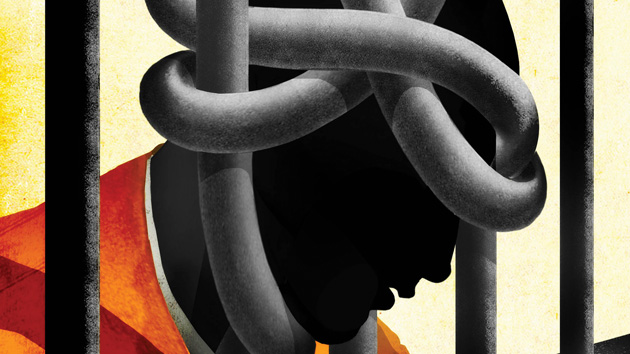
Mother Jones photoillustration by Tim J. Luddy
With all the bluster from Pennsylvania Avenue about executing drug dealers and school shooters and MS-13 members, you may not have noticed that the death penalty has been in a long and steady decline. Executions and death sentences in the United States have dropped more than 75 percent from their highs of two decades ago, and there is no evidence to suggest these trends will reverse themselves. Still, there is a steady drip-drip-drip of state-sanctioned killing, almost entirely in a handful of Southern states, and many participants in the criminal justice system, including several members of the Supreme Court, appear to be wondering when it will all end.
Some cases seem tailor-made to hurry the discussion along, and Texas’ long-grinding case against Andre Thomas is one of them. Thomas’ trial and appeals, which I covered in detail for Mother Jones in 2013, paint a harrowing portrait of mental illness, systemic racism, and an unfathomable crime: Thomas had killed his estranged wife, his four-year-old son, and her 13-month-old daughter, which was shocking enough, but the nature of the crime itself would have been a massive red flag for any mental health professional.
For one thing, Andre had cut out the children’s hearts and returned home with the organs in his pockets. For another, he was careful to use three different knives so that the blood from each body would not cross-contaminate, thereby ensuring that the demons inside each of them would die. He then stabbed himself in the chest, but he did not die as he had hoped.
Thomas’ family tree was replete with domestic violence, parental neglect, substance abuse, and enough genetic markers to predict the schizophrenia that plagued him. But as bizarre as the crime was, and as detailed his troubled past, his behavior afterward stood out even among cases involving extreme mental illness.
Andre refused the anti-psychotic medication the jail doctors prescribed him, but at least he had the Bible, and when he wasn’t acting belligerently or gesticulating wildly or ranting about evil he would read from it. One can only wonder what he thought when he turned to Matthew 5:29—particularly in light of his obsession with the eye on the pyramid. “If your right eye causes you to sin,” the passage reads, “gouge it out and throw it away. It is better for you to lose one part of your body than for your whole body to be thrown into hell.”
And that is precisely what Andre did. Sitting in his cell, reading the Bible, he gouged out his right eye with his fingers.
After three years on death row, Thomas began to act as he had before committing his crimes. He stopped talking and eating, began to feel suicidal, and refused his meds. And then, a few weeks before Christmas 2008, he ripped out his remaining eye—and ate it.
As he explained some days later, he didn’t want the government to read his thoughts, so he ate the eye because he was certain they would figure out some way to put it back in.
Thomas has been blind for close to a decade now, and Texas continues to push for his execution. But last week, during oral arguments on his case before the Fifth Circuit Court of Appeals, federal judges hinted they were troubled by more than just Thomas’ psychoses.
While mental illness pervades every aspect of the case, there was something more sinister at play during Thomas’ trial for capital murder. Thomas is black, and he had killed his estranged wife, who was white. This fact prompted the inclusion of an item on the jury questionnaire about interracial marriage, and four potential jurors indicated they were “opposed” or “strongly opposed” to such pairings. Three of those jurors were seated, and the fourth was chosen as an alternate. Thomas’ court-appointed defense lawyers neither asked two of the three seated jurors a single follow-up question about race to try to disqualify them, nor did they use a peremptory strike to have either of them removed.
Those same defense attorneys who had failed to keep Thomas off death row proved even less helpful during his appeals. They gave prosecutors and Thomas’ new lawyers contradictory statements regarding their own conduct at trial, and they used virtually identical language to explain their failure to probe deeper into the jurors’ antipathy toward mixed marriages: We “questioned them to the extent necessary for us to request a strike for cause or make a decision to use a strike against them.”
One of the lawyers went even further, accusing Thomas’ appellate attorneys of race-baiting and claiming that “the prosecutors and jurors are being accused of racial prejudice without any basis in the record.” It seems that the jurors’ sworn comments regarding interracial marriage—“I don’t believe God intended for this,” “We should stay with our bloodline,” and “[It is] harmful for the children involved because they don’t have a specific race to belong to”—did not meet their threshold for racial bias.
Thomas’ appeals were roundly rejected by Texas state courts, so he moved on to the federal district court in eastern Texas. There, without explanation, his case was passed from one judge to another to a third, until it finally came to rest where it had begun, with Judge Michael H. Schneider, a 2004 appointee of President George W. Bush.
Schneider made short shrift of the mental health and racial bias claims presented by Thomas’ appellate attorneys. Relying on procedural rules ushered in after the Republican takeover of the House of Representatives in 1994, he followed the state courts’ lead by attributing credibility to the statements Thomas’ original lawyers had given to the prosecution after his trial, while ignoring the contradictory statements those lawyers had provided six months earlier to the lawyers representing Thomas in his appeals.
Schneider ruled that the failure of Thomas’ original defense lawyers to press some jurors on perceived racial biases “was simply a matter of trial strategy.” But that would have been a curious strategy in light of the lead prosecutor’s closing argument for execution, which he concluded by asking the all-white jury whether they were willing to risk Thomas “asking your daughter out, or your granddaughter out?”
As for Thomas’ competence to stand trial after gouging his eye out and being committed to the state mental hospital, Schneider sided with the Texas courts in crediting B. Thomas Gray, a clinical psychologist who noted that Thomas had been diagnosed as “malingering” and that he “may engage in gestures or behaviors, including possibly those involving self-harm, in a bid to appear more seriously mentally ill than he is.” (Schneider’s opinion made no mention of whether the doctor may have changed his diagnosis after Thomas removed his second eyeball.)
The ruling left no doubt about Schneider’s views: He denied every issue raised by the defense and declared that no “reasonable jurists” could even debate the merits of Thomas’ claims. His 77-page opinion was published on September 19, 2016—Schneider retired from the federal bench 12 days later.
But the legal winds seem to be shifting in Thomas’ favor. Last year, the Supreme Court handed down two important decisions about discrimination in a criminal law context. Although neither relates directly to Thomas’ fate, both cases showed the court is finally taking a clear-eyed look at the racial elephant in the courtroom.
In Pena-Rodriguez v. Colorado, the high court reversed a sexual assault conviction wherein a juror had condemned the defendant during deliberations “because he’s Mexican and Mexican men take whatever they want…nine times out of ten Mexican men were guilty of being aggressive toward women and young girls.” Unlike the Thomas jurors, who had expressed racial animosity and were not questioned about it by his defense lawyers, the biased juror in Pena-Rodriguez did not reveal his prejudice during jury selection.
The second Supreme Court decision, Buck v. Davis, involved Duane Buck, a Texas death row inmate whose own lawyer put a psychologist on the stand to testify about his client’s likelihood of committing criminal acts of violence that would constitute a continuing threat to society. This expert witness concluded that Buck probably would not engage in further violent conduct, but that because he was black, there was an elevated probability he would.
Chief Justice John Roberts, recognizing that Buck may have been sentenced to death in part because of his race, wrote this was “a disturbing departure from a basic premise of our criminal justice system: Our law punishes people for what they do, not who they are. Dispensing punishment on the basis of an immutable characteristic flatly contravenes this guiding principle.” This was a harsh reversal of the Fifth Circuit’s opinion, which held that Buck had “not made out even a minimal showing” that his case was exceptional.
Like Schneider in the Thomas case, the Fifth Circuit in Buck had determined that no reasonable jurist could argue that Buck’s claim of racial bias had merit. Thomas’ next appellate stop was that very same Fifth Circuit. Had they learned anything from Buck v. Davis? Last week’s oral arguments provided an inkling.
In his book The Supreme Court, the late Chief Justice William Rehnquist wrote about an 1824 case, Gibbons v. Ogden, that involved five days of oral argument before the court. Appeals courts these days rarely allow more than an hour, and so it was in the Thomas case. Still, the racial bias of the jurors was of significant interest to the three-judge panel. When one of the judges asked about the claim by one of Thomas’ trial lawyers that he had avoided questioning those jurors further for fear of creating animosity, Thomas’ appellate attorney was prepared:
He does say that in his second affidavit, which of course is diametrically contrary to the first affidavit he submitted, in which he said, “There was no intentional strategy, I simply just didn’t ask.” What we know here is that these questions were posed to the jurors…in the first place precisely because the interracial dynamics of the facts in this case were so palpable that it was recognized that this was an important question that needed to be asked. So it’s not a reasonable strategy to then say, “Well, I don’t want to inject race into the discussion.” Race was already injected into the discussion, and these jurors gave extremely troubling responses.
When it was the assistant attorney general’s turn to argue, a serious error in the state’s brief was exposed. The prosecution had erroneously claimed all the jurors at issue were questioned further about their views on interracial marriage:
Judge Stephen Higginson: On page 36 of your brief, you say trial counsel extensively questioned all four [jurors] regarding whether Thomas and [the victim’s] race would impact their ability to remain impartial. You said all four indicated it would not. You didn’t give a record [citation]. Is it your position that, when I look at the transcript, that trial counsel questioned [the two jurors in question] as to whether or not their race would impact the ability to remain impartial?
Prosecutor: At this point, I have to admit that that was a mistake.
Judge: It’s a pretty significant mistake.
Prosecutor: It is, Your Honor.
Not surprisingly, Thomas’ severe mental illness came up prominently. When the state attempted to portray the killings as “revenge and obsession,” Higginson was not having it. “It seems like the state admits, and certainly the defense insists, that the defendant was psychotic,” he said. “You’re saying that this was a revenge killing…[and that] does seem to be missing the greater point, that even you acknowledge, that this is a matter of a person who was psychotic at the time.”
Thomas’ attorney ended her presentation by explaining that the trial lawyers had failed to provide an accurate portrayal of her profoundly disturbed client: “What [the jury] should have seen, and what would have gravely affected their evaluation of whether he deserved to die, was that as a little boy he was suffering the effects of this organic mental illness. He needed help. He never got it.”
Higginson concluded the hearing with an understatement. “It’s an important set of questions for us to resolve,” he said. Then, only two days later, the Fifth Circuit panel issued an order acknowledging what was painfully obvious to anyone who was in the courtroom last week: That “reasonable jurists could disagree” on the race and mental illness aspects of the case. The judges then asked both sides to brief them further on those issues.
The order amounts to a rare glimmer of hope for Thomas, who is entering his 14th year on death row. While justice purports to be blind, would a reasonable jurist believe it to be served by executing a severely mentally ill man who blinded himself?
Click here to hear the audio version, read by M.A.S.H. actor Mike Farrell, of Marc Bookman’s award-winning 2013 essay on the Andre Thomas case: “How Crazy Is Too Crazy to Be Executed?”












